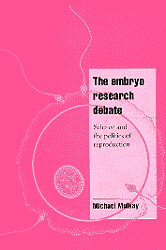
![]()

The book begins by setting the scene for the embryo research controversy. Antecedents such as abortion legislation in the 1960s, the thalidomide episode and the formation of moral pressure groups set the scene for the growth in assisted fertility techniques, and for the formation of a public debate around the need for regulation. The next chapter follows on by tracing the events within parliament from the publication of the Warnock Report in 1984 to the 1990 Commons vote which approved the continuation of embryo research up to the 14 day limit. From initial widespread mistrust and condemnation of embryo research, the debate shifted towards its conclusion (for now), of a much more positive approach to the research. In the remainder of the book Mulkay sets out to examine the factors which led to this shift. Upon the earlier narrative chapters which detail the course of events and the protagonists, Mulkay builds an analysis which pays increasing attention to rhetorical strategies, and to the representations which move between pressure groups, scientists, parliament and the media. He pays attention to the role of political party and ministerial allegiances, to the organisation of pro-research pressure groups, to the role of women and of religion in debate, to media portrayals of the issues, and to the wider cultural themes and myths upon which the debaters drew. In the final chapter he reviews the strategies which proved successful within debate, compares the situation in Britain with the markedly different course of events in the US, and ponders prospects for the future.
In terms of theoretical contribution to the sociology of science, little is made explicit. References to the literature of science and technology studies are economical, and are present mainly only in endnotes. This leaves us with a narrative which can be followed by a reader new to Mulkays work. The book is impressive in its scope, detail and insight, without singing its own theoretical praises. Mulkay uses to great effect the discourse analytic approach to unravelling statements which he had applied to scientists' discourse in the past. Here he applies the approach to a complex web of statements and counter-statements from parliamentary records and the media, moving away from the discourse of scientists which has been the focus of so much of his previous work. The majority of the book is in conventional narrative form, rather than the New Literary Forms with which Mulkay has experimented in the past. Only the Epilogue explores embryo research from this perspective, presenting the embryo research debate as an encounter between life forms in the Fallopian Tube.
As a major contribution to an understanding of embryo research, and to the complexities of parliamentary decision making more broadly, this book is highly impressive. For anyone concerned with developments in research on human embryos and reproductive techniques, it will be an essential read. As a contribution to the sociology of science the book is unpretentious: it aims to convince by example rather than by extended theoretical treatise. It could be taken as a sign of the maturity of sociology of science, that a work based securely on its foundations is able to demonstrate so confidently the analytic purchase which it offers. Recent critics of science studies would do well to read and learn.
Christine Hine
Brunel University